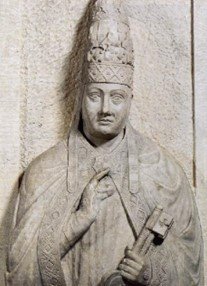Franciscan Poverty
St. Francis of Assisi
Francis of Assisi wanted to imitate Jesus, who had “nowhere to lay his head” (Luke 9:58) and instructed his disciples to “take nothing for the journey” (Luke 9:1-5). Francis never built a church or monastery. He and his followers based themselves at the little church of the Porziuncola (‘little portion’) outside Assisi, but lived in crude wooden huts around the church. They owned no property and lived on whatever food and shelter they were offered by the people they ministered to. Their only garment, of coarse material, was tied at the waist with a rope instead of a belt to show that they carried no money (medieval purses were attached to leather belts). Poverty was so important in Francis’ understanding of his calling that he personified it as the ‘Lady Poverty’ and spoke of being betrothed to her as his bride.
But even before Francis’ death in 1226, some of his followers were seeing things differently. They felt that effective ministry required formal theological education and permanent buildings (churches and friaries) in the cities and towns. These more pragmatic Franciscans were wholeheartedly supported by the Papacy and Church authorities, for whom Francis’ radical poverty was a huge challenge. As the 13th century wore on the pragmatists, with the backing of the Church, gained control of the movement and Franciscan churches and friaries sprang up throughout Europe. But there was always a prominent minority of Franciscans arguing for a return to the original ideal of poverty and seeking to live in simplicity and poverty, often in remote hermitages rather than in the new friaries (or ‘convents’, from which the pragmatists were called Conventuals). These dissenting Franciscans became known as the ‘Spirituals’ and Jacopone was one of them.
It’s difficult for us today to appreciate how important and convulsive was this dispute. Franciscanism was by far the most popular and dynamic movement in 13th-century Christianity, spreading rapidly throughout Europe and becoming hugely influential. In a world where everyone was part of the Church, nobody could be neutral in this dispute. Francis’ ideal of poverty was always an implicit criticism of the growing wealth and power of the Church, but as the century went on some of the Franciscan ‘Spirituals’ made this criticism more explicit. For his part, Jacopone composed laudi lamenting the corruption of the Church (such as laudi LII and LIII), with issues of wealth and poverty always at the forefront of his mind. The Church hierarchy increasingly saw the ‘Spirituals’ as a threat and along with the mainstream Franciscan authorities, sought to marginalise and, on occasion, persecute them.
Then something remarkable happened.
Celestine V
Celestine V
After Pope Nicholas IV died in 1292, rival factions of Cardinals were deadlocked and unable to elect a new Pope for over two years. Finally, in 1294, in an extraordinary compromise, they elected Pietro de Morrone, a holy and elderly hermit, as Pope Celestine V. Many Franciscan ‘Spirituals’ hoped Celestine would support them and this seemed to be borne out when Celestine agreed to establish the ‘Spirituals’ as a separate congregation, free from the authority of the ‘Conventual’ Franciscan establishment. But Jacopone, almost uniquely, was not so optimistic and composed a laude (LIV, ‘Che farai, Pier da Morrone?/ What now, Pier da Morrone?’) warning the new Pope of the difficulties he would face in the Papal court. Jacopone was right: within a few months a bewildered and discouraged Celestine had abdicated. The new Pope, Boniface VIII, quickly reversed Celestine’s provisions for the Spirituals and even imprisoned Celestine, who died shortly afterwards in 1296.
Boniface VIII
Boniface VIII
Boniface was a controversial Pope for many reasons; for the Franciscan ‘Spirituals’ his ambition and avarice represented all that was wrong in the Church. They particularly resented his opposition to their cause and suspected him of pressurising Celestine into abdication, perhaps even of having him murdered (there is no convincing evidence for this). Boniface was quick to restore the status quo, returning the ‘Spirituals’ under the authority of the pragmatic Franciscan ‘Conventuals’. Beyond this, he was not especially hostile to the ‘Spirituals’; their real troubles came under later Popes. Nevertheless, the stage was set for the conflict between Jacopone and Boniface, with painful consequences for Jacopone during his life and for his legacy until the 20th century.


